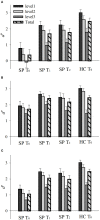Effects of an Audiovisual Emotion Perception Training for Schizophrenia: A Preliminary Study
- PMID: 34025462
- PMCID: PMC8131526
- DOI: 10.3389/fpsyt.2021.522094
Effects of an Audiovisual Emotion Perception Training for Schizophrenia: A Preliminary Study
Abstract
Individuals with schizophrenia show a reduced ability to integrate facial and vocal information in emotion perception. Although emotion perception has been a target for treatment, no study has yet examined the effect of multimodal training on emotion perception in schizophrenia. In the present study, we developed an audiovisual emotion perception training and test in which a voice and a face were simultaneously presented, and subjects were asked to judge whether the emotions of the voice and the face matched. The voices were either angry or happy, and the faces were morphed on a continuum ranging from angry to happy. Sixteen patients with schizophrenia participated in six training sessions and three test sessions (i.e., pre-training, post-training, and generalization). Eighteen healthy controls participated only in pre-training test session. Prior to training, the patients with schizophrenia performed significantly worse than did the controls in the recognition of anger; however, following the training, the patients showed a significant improvement in recognizing anger, which was maintained and generalized to a new set of stimuli. The patients also improved the recognition of happiness following the training, but this effect was not maintained or generalized. These results provide preliminary evidence that a multimodal, audiovisual training may yield improvements in anger perception for patients with schizophrenia.
Keywords: audiovisual; emotion perception; multimodal integration; schizophrenia; training.
Copyright © 2021 Jeong, Kim, Lee and Lee.
Conflict of interest statement
The authors declare that the research was conducted in the absence of any commercial or financial relationships that could be construed as a potential conflict of interest.
Figures



Similar articles
-
Anxiety biases audiovisual processing of social signals.Behav Brain Res. 2021 Jul 23;410:113346. doi: 10.1016/j.bbr.2021.113346. Epub 2021 May 5. Behav Brain Res. 2021. PMID: 33964354
-
Adaptation aftereffects in vocal emotion perception elicited by expressive faces and voices.PLoS One. 2013 Nov 13;8(11):e81691. doi: 10.1371/journal.pone.0081691. eCollection 2013. PLoS One. 2013. PMID: 24236215 Free PMC article.
-
[The mutual interference of facial and vocal information in Chinese and Japanese people's perception of emotions].Shinrigaku Kenkyu. 2017 Apr;88(1):1-10. doi: 10.4992/jjpsy.88.15032. Shinrigaku Kenkyu. 2017. PMID: 29630305 Japanese.
-
Facial emotion perception differs in young persons at genetic and clinical high-risk for psychosis.Psychiatry Res. 2014 May 15;216(2):206-12. doi: 10.1016/j.psychres.2014.01.023. Epub 2014 Jan 23. Psychiatry Res. 2014. PMID: 24582775
-
The Sound and Face of Others: Vocal Priming Effects on Facial Emotion Processing in Posttraumatic Stress Disorder.Psychopathology. 2019;52(5):283-293. doi: 10.1159/000503584. Epub 2019 Oct 30. Psychopathology. 2019. PMID: 31665738
Cited by
-
Subjective Evaluation of Basic Emotions from Audio-Visual Data.Sensors (Basel). 2022 Jun 29;22(13):4931. doi: 10.3390/s22134931. Sensors (Basel). 2022. PMID: 35808423 Free PMC article.
References
-
- Mehl S, Hesse K, Schmidt AC, Landsberg MW, Soll D, Bechdolf A, et al. . Theory of mind, emotion recognition, delusions and the quality of the therapeutic relationship in patients with psychosis - a secondary analysis of a randomized-controlled therapy trial. BMC Psychiatry. (2020) 20:59. 10.21203/rs.2.16385/v2 - DOI - PMC - PubMed
LinkOut - more resources
Full Text Sources

